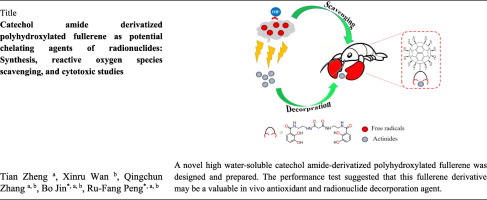当前位置:
X-MOL 学术
›
J. Inorg. Biochem.
›
论文详情
Our official English website, www.x-mol.net, welcomes your feedback! (Note: you will need to create a separate account there.)
Catechol amide derivatized polyhydroxylated fullerene as potential chelating agents of radionuclides: Synthesis, reactive oxygen species scavenging, and cytotoxic studies.
Journal of Inorganic Biochemistry ( IF 3.9 ) Pub Date : 2019-11-14 , DOI: 10.1016/j.jinorgbio.2019.110921 Tian Zheng 1 , Xinru Wan 1 , Qingchun Zhang 2 , Bo Jin 1 , Ru-Fang Peng 1
Journal of Inorganic Biochemistry ( IF 3.9 ) Pub Date : 2019-11-14 , DOI: 10.1016/j.jinorgbio.2019.110921 Tian Zheng 1 , Xinru Wan 1 , Qingchun Zhang 2 , Bo Jin 1 , Ru-Fang Peng 1
Affiliation

|
Radionuclide internal contamination can induce chemical and radioactive intoxication and produce harmful free radicals in vivo. At present, administration of chelating agents is the most effective treatment against nuclide contamination. However, traditional studies on chelating agents have ignored the damage caused by free radicals to the body. The present study aimed to develop a type of a bifunctional sequestering agent that can chelates nuclides and scavenges free radicals simultaneously. Therefore, a novel catechol amide-derivatized polyhydroxylated fullerene was designed and prepared. The poor water solubility of fullerene was ameliorated by chemically modifying hydrophilic catechol amide and multiple hydroxyl groups, and obtaining high water-soluble fullerene derivatives. The affinities of chelators were investigated via sulfochlorophenol competitive complexing method and antioxidant capacities were examined by electron paramagnetic resonance. The results revealed the good complexation of the designed and synthesized chelating agent with uranyl ions; and its efficiency in scavenging hydroxyl radicals. This chelating agent showed extremely low toxicity and notable protective effect against oxidative stress on A549 cells. Besides, in U(VI)-exposed A549 cells, immediate treatment with catechol amide-derivatized polyhydroxylated fullerene significantly decreased the lactate dehydrogenase (LDH) release by inhibiting the cellular U(VI) intake, promoting the intracellular U(VI) release and inhibiting the production of intracellular reactive oxygen species (ROS). These results suggest that this fullerene derivative may be a valuable in vivo antioxidant and radionuclide decorporation agent.
中文翻译:

邻苯二酚酰胺衍生的多羟基化富勒烯作为放射性核素的潜在螯合剂:合成,活性氧清除和细胞毒性研究。
放射性核素的内部污染可引起化学和放射性中毒,并在体内产生有害的自由基。目前,螯合剂的施用是针对核素污染的最有效的治疗方法。但是,传统的螯合剂研究忽略了自由基对人体造成的损害。本研究旨在开发一种可以螯合核素并同时清除自由基的双功能螯合剂。因此,设计并制备了一种新型的邻苯二酚酰胺衍生的多羟基化富勒烯。通过化学修饰亲水性邻苯二酚酰胺和多个羟基,并获得高水溶性的富勒烯衍生物,可以改善富勒烯的不良水溶性。通过磺基氯苯酚竞争络合法研究了螯合剂的亲和力,并通过电子顺磁共振法检测了其抗氧化能力。结果表明,所设计合成的螯合剂与铀酰离子具有良好的络合性。及其清除羟基自由基的效率。这种螯合剂显示出极低的毒性,并且对A549细胞的氧化应激具有显着的保护作用。此外,在暴露于U(VI)的A549细胞中,立即用儿茶酚酰胺衍生的多羟基化富勒烯处理可通过抑制细胞摄取U(VI),促进细胞内U(VI)释放和抑制而显着降低乳酸脱氢酶(LDH)的释放。细胞内活性氧(ROS)的产生。
更新日期:2019-11-14
中文翻译:

邻苯二酚酰胺衍生的多羟基化富勒烯作为放射性核素的潜在螯合剂:合成,活性氧清除和细胞毒性研究。
放射性核素的内部污染可引起化学和放射性中毒,并在体内产生有害的自由基。目前,螯合剂的施用是针对核素污染的最有效的治疗方法。但是,传统的螯合剂研究忽略了自由基对人体造成的损害。本研究旨在开发一种可以螯合核素并同时清除自由基的双功能螯合剂。因此,设计并制备了一种新型的邻苯二酚酰胺衍生的多羟基化富勒烯。通过化学修饰亲水性邻苯二酚酰胺和多个羟基,并获得高水溶性的富勒烯衍生物,可以改善富勒烯的不良水溶性。通过磺基氯苯酚竞争络合法研究了螯合剂的亲和力,并通过电子顺磁共振法检测了其抗氧化能力。结果表明,所设计合成的螯合剂与铀酰离子具有良好的络合性。及其清除羟基自由基的效率。这种螯合剂显示出极低的毒性,并且对A549细胞的氧化应激具有显着的保护作用。此外,在暴露于U(VI)的A549细胞中,立即用儿茶酚酰胺衍生的多羟基化富勒烯处理可通过抑制细胞摄取U(VI),促进细胞内U(VI)释放和抑制而显着降低乳酸脱氢酶(LDH)的释放。细胞内活性氧(ROS)的产生。


























 京公网安备 11010802027423号
京公网安备 11010802027423号